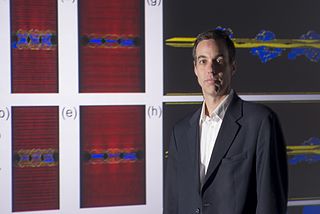
A simulation is an imitative representation of a process or system that could exist in the real world. In this broad sense, simulation can often be used interchangeably with model. Sometimes a clear distinction between the two terms is made, in which simulations require the use of models; the model represents the key characteristics or behaviors of the selected system or process, whereas the simulation represents the evolution of the model over time. Another way to distinguish between the terms is to define simulation as experimentation with the help of a model. This definition includes time-independent simulations. Often, computers are used to execute the simulation.

The Ames Research Center (ARC), also known as NASA Ames, is a major NASA research center at Moffett Federal Airfield in California's Silicon Valley. It was founded in 1939 as the second National Advisory Committee for Aeronautics (NACA) laboratory. That agency was dissolved and its assets and personnel transferred to the newly created National Aeronautics and Space Administration (NASA) on October 1, 1958. NASA Ames is named in honor of Joseph Sweetman Ames, a physicist and one of the founding members of NACA. At last estimate NASA Ames had over US$3 billion in capital equipment, 2,300 research personnel and a US$860 million annual budget.

A flight simulator is a device that artificially re-creates aircraft flight and the environment in which it flies, for pilot training, design, or other purposes. It includes replicating the equations that govern how aircraft fly, how they react to applications of flight controls, the effects of other aircraft systems, and how the aircraft reacts to external factors such as air density, turbulence, wind shear, cloud, precipitation, etc. Flight simulation is used for a variety of reasons, including flight training, the design and development of the aircraft itself, and research into aircraft characteristics and control handling qualities.

FlightGear Flight Simulator is a free, open source multi-platform flight simulator developed by the FlightGear project since 1997.
SPICE is a general-purpose, open-source analog electronic circuit simulator. It is a program used in integrated circuit and board-level design to check the integrity of circuit designs and to predict circuit behavior.

McMaster University is a public research university in Hamilton, Ontario, Canada. The main McMaster campus is on 121 hectares of land near the residential neighbourhoods of Ainslie Wood and Westdale, adjacent to the Royal Botanical Gardens. It operates six academic faculties: the DeGroote School of Business, Engineering, Health Sciences, Humanities, Social Science, and Science. It is a member of the U15, a group of research-intensive universities in Canada.

Computer simulation is the running of a mathematical model on a computer, the model being designed to represent the behaviour of, or the outcome of, a real-world or physical system. The reliability of some mathematical models can be determined by comparing their results to the real-world outcomes they aim to predict. Computer simulations have become a useful tool for the mathematical modeling of many natural systems in physics, astrophysics, climatology, chemistry, biology and manufacturing, as well as human systems in economics, psychology, social science, health care and engineering. Simulation of a system is represented as the running of the system's model. It can be used to explore and gain new insights into new technology and to estimate the performance of systems too complex for analytical solutions.
Simulation video games are a diverse super-category of video games, generally designed to closely simulate real world activities. A simulation game attempts to copy various activities from real life in the form of a game for various purposes such as training, analysis, prediction, or entertainment. Usually there are no strictly defined goals in the game, and the player is allowed to control a character or environment freely. Well-known examples are war games, business games, and role play simulation. From three basic types of strategic, planning, and learning exercises: games, simulations, and case studies, a number of hybrids may be considered, including simulation games that are used as case studies. Comparisons of the merits of simulation games versus other teaching techniques have been carried out by many researchers and a number of comprehensive reviews have been published.

Michael James Massimino is an American professor of mechanical engineering at Columbia University and a former NASA astronaut. He is the senior advisor of space programs at the Intrepid Sea, Air & Space Museum.

A heliodon (HEE-leo-don) is a device for adjusting the angle between a flat surface and a beam of light to match the angle between a horizontal plane at a specific latitude and the solar beam. Heliodons are used primarily by architects and students of architecture. By placing a model building on the heliodon’s flat surface and making adjustments to the light/surface angle, the investigator can see how the building would look in the three-dimensional solar beam at various dates and times of day.
In computer network research, network simulation is a technique whereby a software program replicates the behavior of a real network. This is achieved by calculating the interactions between the different network entities such as routers, switches, nodes, access points, links, etc. Most simulators use discrete event simulation in which the modeling of systems in which state variables change at discrete points in time. The behavior of the network and the various applications and services it supports can then be observed in a test lab; various attributes of the environment can also be modified in a controlled manner to assess how the network/protocols would behave under different conditions.

Scott Fisher is the Professor and Founding Chair of the Interactive Media Division in the USC School of Cinematic Arts at the University of Southern California, and Director of the Mobile and Environmental Media Lab there. He is an artist and technologist who has worked extensively on virtual reality, including pioneering work at NASA, Atari Research Labs, MIT's Architecture Machine Group and Keio University.
The Carnegie Institution for Science, also known as Carnegie Science and the Carnegie Institution of Washington, is an organization in the United States established to fund and perform scientific research. The institution is headquartered in Washington, D.C. As of June 30, 2020, the Institution's endowment was valued at $926.9 million. In 2018 the expenses for scientific programs and administration were $96.6 million. Eric Isaacs is president of the institution.
Modeling and simulation (M&S) is the use of models as a basis for simulations to develop data utilized for managerial or technical decision making.
Vortex Studio is a simulation software platform developed by CM Labs Simulations. It features a real-time physics engine that simulates rigid body dynamics, collision detection, contact determination, and dynamic reactions. It also contains model import and preparation tools, an image generator, and networking tools for distributed simulation which is accessed through a desktop editor via a GUI. Vortex adds accurate physical motion and interactions to objects in visual-simulation applications for operator training, mission planning, product concept validation, heavy machinery and robotics design and testing, haptics devices, immersive and virtual reality (VR) environments.

Gerhard Klimeck is a German-American scientist and author in the field of nanotechnology. He is a professor of Electrical and Computer Engineering at Purdue University School of Electrical and Computer Engineering.

The origin of the Moon is usually explained by a Mars-sized body striking the Earth, creating a debris ring that eventually collected into a single natural satellite, the Moon, but there are a number of variations on this giant-impact hypothesis, as well as alternative explanations, and research continues into how the Moon came to be formed. Other proposed scenarios include captured body, fission, formed together, planetesimal collisions, and collision theories.

Alejandro Strachan is a scientist in the field of computational materials and the Reilly Professor of Materials Engineering at Purdue University. Before joining Purdue University, he was a staff member at Los Alamos National Laboratory.
A number of significant scientific events occurred in 2018.
The artificial sky is a daylight simulation device that replicates the light coming from the sky dome. An architectural scale model or 1:1 full-scaled aircraft is placed under an artificial sky to predict daylight penetration within buildings or aircraft that subjects to different situations, complex geometries, or heavily obstructed windows. The concept of the artificial sky was derived due to heliodon’s limitation in providing a stable lighting environment for evaluating the diffuse skylight component.











